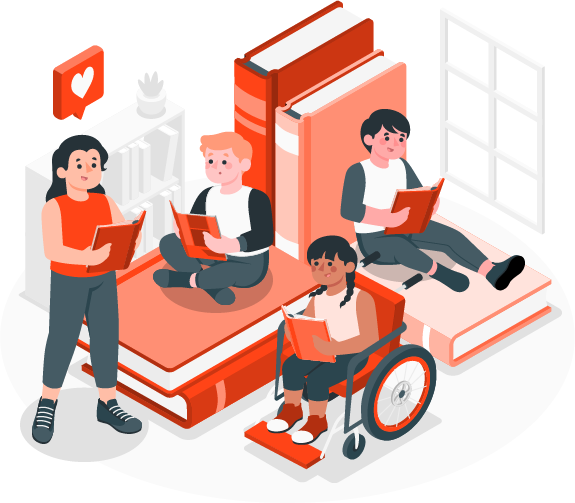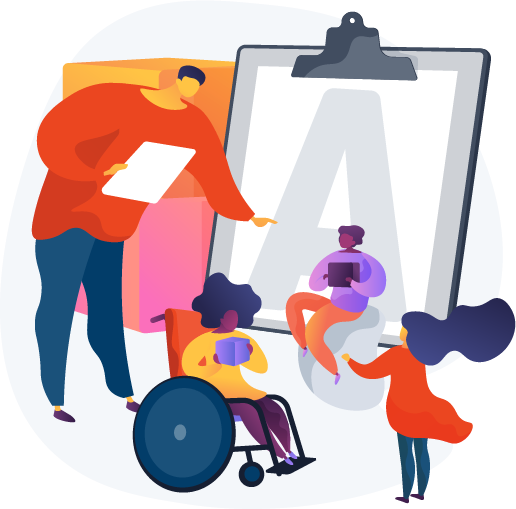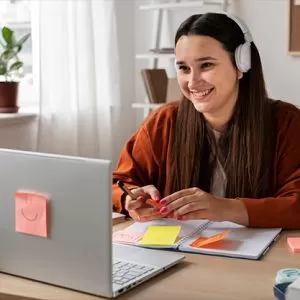Hybrid teaching and learning approaches have become increasingly common in modern education. Building an inclusive online classroom is important with the rise in flexible and hybrid teaching and learning options. Teachers and educational institutes are increasingly adopted effective strategies and practices to make the online learning system equitable and accessible to meet the diverse needs of learners. The advancements in the education system made inclusivity a fundamental necessity and a core requirement rather than a luxury.
Key Takeaways:
- Inclusive online education ensures that all students, regardless of background, ability, or learning style, have equal opportunities to participate, engage, and succeed in a virtual classroom.
- Strategies such as Universal Design for Learning (UDL), differentiated instruction, and social-emotional support help build a flexible, accessible, and empathetic online learning environment.
- Implementation of Inclusive practice in a classroom comes with challenges like limited resources, inadequate training and rigid policies of the educational system.
An inclusive education system fosters a learning space where every learner, irrespective of their background, race, gender, abilities and disabilities, feels valued and well-respected, empowered and provided with equal opportunities to actively engage in classroom experiences, enriching their educational journey and fostering a strong sense of belonging.
In this blog, we will explore the inclusivity in modern classrooms and strategies that educators offer to support diverse learners.

What is Inclusive Education?
Inclusive education is where all learners in a particular classroom are given equal opportunities and are treated with fairness and impartiality. It addresses the diverse needs of learners in a class coming from different cultural backgrounds and varied abilities, ensuring everyone has access to high-quality and standardised education.
In a recent UNICEF (2025) report, approximately 240 million children globally live with disabilities, often facing significant barriers to accessing education and fully participating in social, economic, and political life.
Inclusive education aims to eliminate the barriers between education and learning by creating an environment where learners can freely participate, contribute and thrive together. It provides every individual a fair chance to go to school, learn and develop their skills.
The benefits of an inclusive learning environment are not solely limited to individual learners but extend to a broader societal scale. Inclusive education is a powerful tool for promoting social justice and fostering equality for learners coming from diverse backgrounds. It empowers learners and provides better opportunities for academic achievements, encourages social interactions and develops life skills such as empathy and mutual respect.
Strategies to Create an Inclusive Online Classroom Environment
There are several strategies that can be utilised to create an inclusive education environment remotely for all types of learners. Providing a space that is flexible for learner yet they feel connected, valued, well-respected and supported regardless of their background, race, gender, and abilities.
The following are a few strategies that can be used to create an inclusive learning environment in the online classroom.
Create a Safe Learning Environment
To create an inclusive virtual classroom, it is important that students feel safe and are protected emotionally and psychologically in the learning space. Psychological well-being in an online classroom is as important as being physically safe in a physical education system. The first step towards making online learning inclusive is to regulate respectful language while interacting in chat, class groups or during group projects. Positive interaction must be encouraged. Have regular check-ins with the class and seek anonymous feedback.
Taking Care of Students’ Needs
Online learning comes with its own challenges, such as connection issues, the absence of a professional learning environment, different learning abilities of learners, and a lack of understanding of the learning material. All of these challenges can be addressed by being flexible in providing lecture material in multiple formats, such as recorded lectures, live chats, lesson material, PDFs, audio resources or having virtual sessions with the students who require special attention.
Universal Design for Learning (UDL)
A thoughtful, accessible teaching practice promotes inclusive education. The application of the principles of Universal Design for Learning improves and optimises teaching and learning that aims to meet the needs of all student learners and make learning environments accessible and challenging for all students. Educators make sure to use platforms for teaching online that are user-friendly, mobile-friendly and accessible to assistive technology. Deliver interactive lessons and use elements such as polls, engaging captions and discussion forums, providing learners with various ways to interact and participate.
Encourage Collaborative Learning and Peer Support
Group projects and collaboration are as important in online learning as they are in physical classes. Breakout rooms can be used to hold discussions, group tasks, peer discussions, or virtual self-study sessions for learners. Educational collaborative tools such as Padlet, Jamboard or Google Docs can be used for real-time collaborations. Educators keep assigning them tasks where learners can use collaborative skills to reduce isolation and build a sense of community.
Support Social and Emotional Learning (SEL)
Remote learning can weigh on learners, becoming emotionally taxing. One of the reasons is that learners are disconnected from other learners because they are not in the traditional classroom setting. To reduce this feeling, integrate SEL by starting with emotional check-ins and simple wellness questions. Specify a time for casual discussion with students with the name of fun-time where learners feel safe to share their thoughts or seek advice if they want. A strong SEL focus helps students feel balanced, emotionally supported, and more ready to learn
Develop a Rapport with Each Student
In an online education setting, a relationship with learners just does not automatically form; it takes the intentional efforts of the teacher as well as learners. Reach out to students who feel disengaged in the classroom, give them personalised attention in the class or during tasks, and keep interacting with them, motivating them to participate in class. Even a short, personal message can go a long way in making learners feel valued and seen.
Ready to enhance your teaching skills with the latest technology?Kickstart your teaching career!
Gain the skills to lead inclusive, engaging lessons and support every learner.
Enrol Now!

Challenges in Implementing Inclusive Education
Implementing inclusive education in remote education comes with its own challenges. Even though inclusivity is a necessity of today’s education system, implementing these principles in an educational setting still comes with many hurdles. The following are some common challenges faced by the education sector during the implementation of inclusivity.
Teacher Training and Capacity: One of the challenging situations is providing adequate training to educators, especially in a dynamic and remote classroom. Understanding the use of ever-advancing assistive technology, adapting the learning materials digitally, and fulfilling the individual needs of learners requires time and a different skill set than traditional classroom teaching.
Resource Constraints: Inclusive online education cannot be executed with just a laptop and a stable internet connection; it also requires paid access to specialised tools to ease the whole process, making it less time-consuming.
Societal and Attitudinal Barriers: Biases and misunderstandings about abilities, disabilities, and language differences can affect how inclusion is prioritised in online spaces. Teachers and administrators fail to accommodate diverse learning needs, especially when they are not in traditional educational settings. These underlying attitudes can create a sense of exclusion, even in a remote setting.
Conservative Policies: The educational sector is still grounded in the traditional framework. Assessment, fixed deadlines and curriculum do not fit in inclusive online learning. These standard policies of the educational system limit the teacher’s ability to provide flexibility in all learning matters.
Technological Barriers: Online learning is executed by totally depending on technology, which is also considered a stumbling block of inclusion in learning. Not everyone can have access to stable and reliable internet, digital devices or tech-literate family support. Most of the learning platforms are not user-friendly and restrict their use to a specific type of device. The accessibility is also a concern in using such platforms, creating difficulty for learners with visual, auditory or cognitive impairments to participate in lessons like every other learner.
Curriculum Limitations: Most of the curriculum that can be delivered online is designed for average learners rather than the ones with diverse abilities, interests and cultures. They are not given options like differentiated learning tasks, multiple assessment formats or culturally responsive content. The lack of flexibility suppresses inclusive learning in digital settings.
While these challenges can seem daunting, they are not hard to manage. With thoughtful planning and the proper support, educators can implement practical solutions to foster more inclusive online learning experiences for all.
This method is helpful in online or blended classrooms where real-time data can be derived to engage learners with timely interventions. Moreover, regular formative assessments also help learners track their progress to participate in self-directed learning.
| Challenge | Potential Solution |
|---|---|
| Teacher Training and Capacity | Regular CPDs on inclusive practices and assistive technologies |
| Resource Constraints | Funding for specialised tools and access to cost-effective or open-source platforms for both teachers and learners |
| Societal and Attitudinal Barriers | Staff training on inclusion and diversity; implementation of inclusive values and policies |
| Conservative Policies | Flexible deadlines, alternative assessment methods, and differentiated curriculum structures |
| Technological Barriers | Device loan schemes, offline content access, accessible platforms, and digital literacy support |
| Curriculum Limitations | Adapted curriculum with differentiated tasks, multiple assessment methods, and culturally responsive content |
These actions can help create a more balanced and welcoming learning space where all learners have the chance to thrive.
Conclusion
The use of technology in the classroom is transforming the teaching and learning experience. Edtech provides an engaging, accessible, and personalised learning environment for learners. Currently, the possibilities for using technology to enhance learning are wide. From social media to artificial intelligence, trends are giving educators ideas to keep themselves updated and relevant to the industry. With the use of the right tools, technology can promote engaging, efficient and practical education that aligns with the demand of the technology-driven era.





